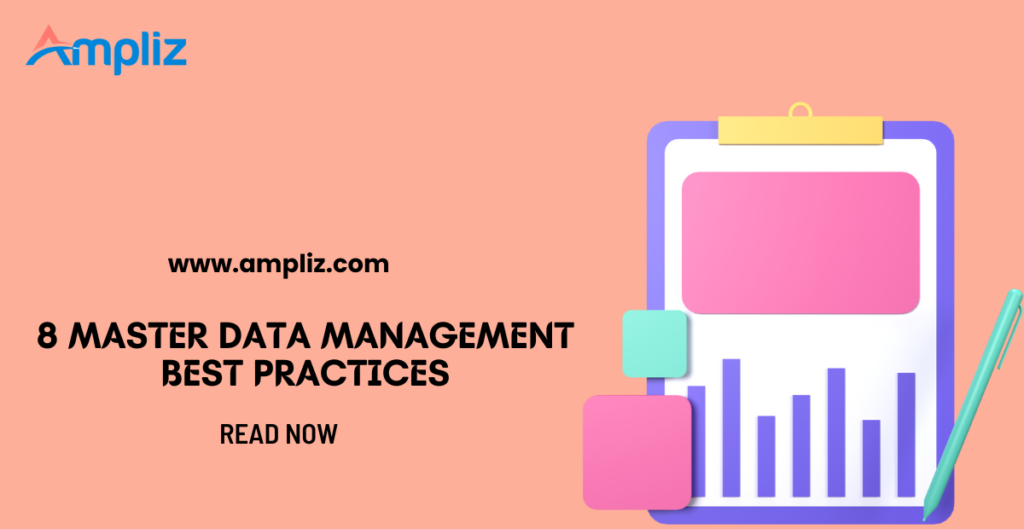The quality of your master data can only be as good as the quality of the master data management (MDM) system you have in place. If your system is compromised, the same will reflect on the master data. The issue will also trickle down to all business processes relying on the data.
That’s a real problem because modern businesses rely on master data to deliver a consistent customer experience, boost revenue, increase business efficiency, and so on.
Fortunately, maintaining a reliable MDM system is not as hard as it may sound. You just need to pick the correct solution and follow the right master data management best practices.
So, in today’s article, I will take you through eight master data management best practices that will help you build and retain a solid MDM system. But first:
What is master data management?
Master data management (MDM) is a complete system for managing and unifying an organization’s data assets. It involves utilizing various tools, strategies, and procedures to guarantee precise and reliable master data across systems and departments within an organization.
For your perusal, master data comprises information such as employee, supplier, product, customer, operations data.
The primary objective of MDM is to establish a single, credible source of master data for use throughout the organization. However, it has additional benefits, including:
- Enhancing data quality and operational efficiency by removing duplicates and adhering to data standards.
- Improving data integration and compatibility, allowing for smooth data transfer, improved analysis, and reporting.
- Facilitating better collaboration and integration across departments and systems, fostering a more cohesive and aligned approach to data management within the organization.
- Supporting compliance and risk management by establishing data governance policies and ensuring data integrity and accountability.
- Ensuring that information is up-to-date and precise, enabling businesses to make informed decisions and respond quickly to market changes.
In other words, if you don’t have a master data management system just yet, you’re missing out.
8 Essential best practices for master data management
When it comes to implementing MDM, however, it’s not enough for you to collate all your data into a single platform. There are several master data management best practices organizations should follow. Let’s go through each one.
1. Focus on data governance
Data governance has a tremendous impact on the success of any master data management framework. Remember that handling and stewardship of master data changes a lot throughout its lifespan. Within weeks, business data can move from your sales funnel down to other departments like the finance, accounting, marketing, and IT departments.
For example, your business could acquire customer data from the marketing department. That data can further be moved to the sales team when a prospect becomes a customer. The very same data can be shared with your customer support team. The finance and accounting team would also access the data when creating business reports. Social media team can use it to get more Instagram followers or Facebook friends. Even the IT team could access, modify, or delete the data.
The more the data changes hands, the higher the chances that its quality could get compromised. To avoid that, you have to implement a proper data governance strategy. The strategy needs to explain the policies, stewardship, and ownership of that data.
You’ll need to set up governance policies showing who can access the data, who can edit it, how the edits are authorized, how long the data is kept, when and who has the permission to delete the data, etc. You must also ensure that every unit within your business understands this policy.
Setting up a fool-proof master data governance strategy helps you maintain a high-quality and reliable MDM framework. That, in turn, helps retain the MDM dashboard as a single source of truth, allowing your business to utilize the data for decision-making and other critical uses.
2. Update data for privacy and security
As the digital world grows and the volume of data increases, data privacy becomes even more invaluable. EU’s General Data Protection Regulation (GDPR) was perhaps the first of many data privacy regulations.
The CCPA is another powerful law that ensures the privacy rights and consumer protection of California residents in the United States. Since its implementation in 2018, companies are required to inform customers about the types of information they can collect from them.
Check out this page from Voila Norbert, which has published the brand’s statement in compliance with the CCPA:
2021 also saw Apple introduce its own major privacy update. That update gave users the option to block device ID tracking. We’re likely to see more and stricter data privacy regulations in the future.
Therefore, to maintain a competitive MDM, you must continually update your MDM system for privacy and security. Doing this doesn’t just ensure that your MDM framework complies with legal regulations. It also boosts brand reputation.
The good news is that modern master data solutions like IBM InfoSphere Master Data Management and Ataccama provide automatic background updates. This ensures your privacy and security measures are constantly updated and compliant with regulations.
2. Opt for a cloud-based data management solution
A cloud-based master data management solution is better than an on-premise solution for most businesses. Why is that? For starters, a cloud-based solution can be more cost-effective and flexible.
Setting up a robust on-premise MDM solution will require a substantial budget. The upfront costs for acquiring the gear, infrastructure, and experts needed are usually too expensive for most businesses. The running costs also tend to increase as your master records increase.
Cloud-based solutions help cut costs by allowing you to outsource data management. That saves you from the massive initial upfront cost.
Luckily, these cloud-based MDM solutions consistently implement a SaaS marketing strategy in which consumers are only charged on a subscription basis. They allow you to pick and choose the package you want based on your needs.
That means you don’t have to spend more than is necessary. Additionally, it means you can always upgrade to a more robust package as your master data increases or as your business needs evolve.
Cloud-based MDM solutions also tend to provide higher security levels than what most businesses can afford with an on-premise system. These solutions use economies of scale to pay for top-of-the-line cloud service providers like Amazon Web Services and Microsoft Azure. They then extend those services to their customers at friendlier prices.
4. Ensure accessibility to master data
Customer data privacy and MDM governance policies and procedures are critical. Make no mistake about that. However, too many businesses focus on safeguarding the data and overlook its accessibility. That’s a mistake. Placing barriers between your team and the master data introduces bottlenecks that slow down operations and hurt your bottom line.
Also, think about it; the master data you’ve spent so much money collecting and managing becomes pointless if your team cannot access and utilize it, right? That’s why you should prioritize access to the master data.
So, get a master data management solution that allows your staff to access the data they need easily. If you need to adjust the system to ensure your remote teams can access the data, do so. Of course, that should be achieved without compromising data privacy and security.
5. Align MDM with your business goals
A master data management system is supposed to work for you. This system has to align with the SMART goals of your business. Otherwise, it will be another pointless and expensive business expenditure.
But, how exactly do you align an MDM with business goals? You must first identify your business goals, then ask yourself how the MDM system can help you achieve those goals.
Let’s say, for example, you want to improve lead generation. The first question would be, how many leads do you want to collect by the end of the month or quarter? Then, look at your master data management system. Ask yourself the following questions again:
- How can it help you capture more data?
- Does it have the capacity to hold that much data?
Next, let’s say you want to do better customer segmentation to help your marketing and sales team generate more revenue. Ask yourself this: does the system you’re eying help you segment your customer database? Does it make it easier to qualify leads and close more sales?
What about employee efficiency? Can the MDM system help you boost employee productivity? Will it make it easier for every staff member to access the data they want efficiently? Will it improve team collaborations?
So, don’t just set up an MDM for the sake of it. Instead, look at your business goals, then ask yourself how you can create a master data management framework that helps you accomplish those goals. After all, the investment you’re putting into the MDM solution should have an ROI.
6. Organize the data
Proper data organization is the other critical master data management best practice. The goal here is to organize the master data to simplify processes like accessibility, retrieval, usage, etc.
Proper master data organization supports other master data management best practices discussed above. For example, master data accessibility improves tremendously when every piece of that data is categorized and stored correctly. That means your employees can easily use the data to complete their objectives and achieve organizational goals.
Moreover, organized data makes it easier to enforce master data governance. Each business unit will know the data sets they have access to. They’ll also know the permissions they have on handling that data. That should improve accountability and overall data privacy.
7. Leverage machine learning
Machine learning is a field centered around the creation of algorithms and statistical models that allow computers to learn and make decisions without explicit programming. See the differences between machine learning and two other concepts you’ve also probably already heard of: artificial intelligence and deep learning:
Machine learning algorithms’ capacity to analyze enormous volumes of data and discover patterns or relationships has reshaped businesses. In healthcare, for example, machine learning forecasts illness outcomes and offers customized therapies. Also, in transportation, it has enabled the development of self-driving automobiles, effective route planning, and so on.
Machine learning, in the context of Master Data Management (MDM), can allow the identification of patterns, relationships, and anomalies in data. Trained models can be used to automate various tasks and processes in MDM, such as data cleansing, data matching, and data enrichment.
For example, with its ability to automatically match and merge similar datasets, machine learning can streamline data integration processes and ensure data consistency across multiple systems. This ensures a competitive edge by providing reliable, high-quality data for strategic initiatives.
8. Ensure adequate human involvement
Although machine learning models can help enhance MDM processes, human involvement is still vital. After all, MDM processes require comprehension of the context and even the smallest subtleties of the data.
Humans can analyze and interpret data, detect anomalies or discrepancies, and decide how to manage and solve them. They can also create and enforce data governance regulations and standards that guarantee data accuracy and consistency.
Moreover, humans can ensure that data is adequately integrated across various systems and platforms.
To ensure adequate human involvement in MDM, there are several strategies you can implement. Establish distinct roles and responsibilities for those involved in the process. This involves assigning particular individuals or teams to handle every aspect in the system. Such an approach can ensure accountability and ownership of the data being managed.
Additionally, provide training and education to your team to ensure they have the necessary skills and knowledge. This can include training on data management best practices, data enrichment, data quality standards, etc. This way, your MDM teams can make informed decisions and take appropriate actions to improve data quality and governance when necessary.
Furthermore, it is crucial to create a transparent system of communication and cooperation between MDM teams and other parties involved. This ensures effective coordination and alignment of efforts with the overall business strategy.
In closing
That’s it for master data management best practices. To recap, you need to focus on data governance, update your data for privacy & security, use a cloud-based MDM solution, and boost accessibility to the master data. Moreover, you should align MDM to your business goals and, finally, organize the data. Finally, leverage machine learning and ensure adequate human involvement.
By following these best practices, organizations can lay a solid foundation for effective data management.
They will help you build a robust MDM that will boost customer experience and relationships, bringing you closer to your ultimate business goals.




